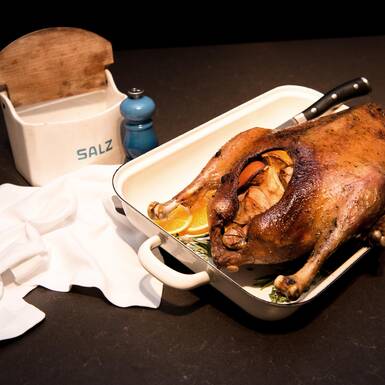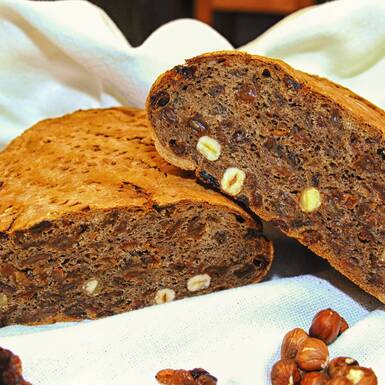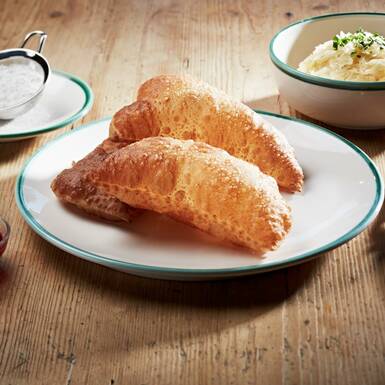- Cuisine
Sweet Oster-Kranzerl
Easter wreath bread - entwined with the customs of Easter. In Saalbach Hinterglemm, the sweet plaited Easter wreath is traditionally presented as a gift to Godchildren on Easter Sunday. For Saalbach Stories, I met up with Elfriede Steger, who revealed her recipe for this sweet bread wreath.
Elfriede and Rudi Steger are the proprietors of the Hotel Barbarahof in Saalbach. Their son, Roland and daughter in law, Katrin, took over the hotel in summer 2016. However, Elfriede remains the boss in the kitchen. Elfriede was born and bred in the Glemm valley and grew up with her three sisters at the nearby Unterreithof and has fond memories of the Easter traditions that were celebrated in the family.
Palm Sunday and Good Friday Traditions
"On Palm Sunday we woke up early and made our way to church with our freshly bound palms, decorated with colourful crepe paper. The consecrated palm branches were then placed in a corner of a room, devoted to prayer, in order to bless the house with happiness. During a bad thunderstorm in summer, a palm branch would be thrown onto the open fire. On Maundy Thursday, it was tradition to paint the Easter eggs with a mixture of fresh flowers and herbs from the meadow, such as Cowslip. This mixture, along with vinegar, gave the egg coating a brown marbled effect.” Whilst sitting in the cosy kitchen preparing the Easter wreath ingredients, Elfriede smiles as she recalls “Good Friday was a strict day of fasting, but my favourite dish accompanied by sauerkraut was always served!
A present for the Godchildren
Elfriede Steger mixes the ingredients and kneads the dough with her hands, until smooth and allows the dough stand as she recalls her memories of Easter. “On Easter Eve, we went to church where the baptism water was consecrated. At this service everyone receives a candle which they light in the darkened church. Even today, I attend this service at the church in Saalbach at 21:00 on Easter Eve.” In the meantime, the dough is ready and with expert hands, Elfriede divides the dough into 18 parts which are rolled and made into 8 perfect plaits, which in turn are placed and formed into wreaths on a baking tray. Elfriede continues “On Easter Sunday, in accordance with an old tradition, a beautiful basket was decorated and filled, with bread, bacon, Easter eggs, salt, butter and Easter pastries. At the church service, the baskets were blessed with holy water and later enjoyed at a family Easter buffet, followed by an Easter egg hunt in the garden.”
Passing on traditions
While the Easter bread wreaths turn golden brown and the sweet smells waft around the kitchen, Elfriede explains “This sweet smell of baking awakens childhood memories of Easter. We always received the sweet bread wreaths as presents from our Godparents. All the Easter customs and traditions that my husband, Rudi and I learnt about in our childhood, have been passed down to our two daughters and son, Roland. We now have three grandchildren who will also learn these traditions." In the meantime, Elfriede has taken the fragrant wreath out of the oven to cool down. Elfriede still enjoys baking this Easter specialty and explains: "If the Barbarahof is still open at Easter, all the guests receive an Easter wreath, otherwise I only bake them for my family and Godchildren." As a finishing touch, Elfriede now carefully places a colourful Easter egg in the middle of each wreath and proudly presents her finished Osterkranzerl. Of course we sampled the Easter wreath as soon as it was baked, but in the way that Elfriede is used to, with butter and homemade apricot marmalade!
Ingredients for 6 bread wreaths
- 400 g all-purpose flour
- 1 sachet dry yeast
- ½ teaspoon salt
- 1 sachet vanilla sugar
- Lemon zest (to taste)
- 50 g sugar
- 50 g butter (room temperature)
- 2 eggs (room temperature)
- 1/8 l lukewarm milk
- 1 egg yolk with a splash of milk
- Decorating sugar to sprinkle
Preparation:
Sieve the flour into a bowl and mix together with dry yeast. Add the salt, vanilla sugar, lemon zest, sugar, butter, eggs and lukewarm milk and knead with the hands. Place the dough on a lightly floured surface and continue to knead until smooth and supple. The dough can also been kneaded in electric mixer. Put the dough back in the bowl and let it rest for an hour. Place the dough onto a lightly floured surface and divide into 18 equal parts, as well as 3 parts which should be formed into longer rolls in order to plait them. Place the plait onto a lightly greased baking tray and use your hands to form a wreath, making sure the ends are secured. Follow the same procedure with the rest of the dough until there are 6 wreaths. Brush lightly with yolk-milk mixture, sprinkle with decorating sugar and leave to stand for 10 minutes. Place the wreaths in the oven and bake for 30 minutes at 180 °C. Once the wreaths have cooled down, decorate with a colourful Easter











